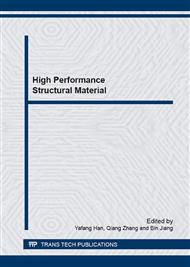p.736
p.743
p.750
p.755
p.761
p.769
p.775
p.781
p.788
Effect of Cooling Procedure on Tensile and Charpy Impact Properties of Cr-Mo Ultra-High Strength Steel
Abstract:
The effect of cooling procedure on the transformation behavior of low-carbon Cr-Mo microalloyed steel was investigated by using microstructural observations, mechanical properties and impact fractographs. Three steel plates were adopted under three different cooling rates, and their microstructure, tensile and impact properties were evaluated. The results indicated that the strength of experimental steels was increased and the impact toughness was decreased with decreasing the coiling temperature. Steel A consisted of granular bainite, coarse bainitic ferrite lath and M/A constituent subjected to a coiling temperature of 560 oC. The yield strength, tensile strength and impact energy of 1/2-size Charpy impact at-20 oC were 740MPa, 1020MPa, and 33.5J, respectively, which were imperfect in strength. The effects of coiling temperature were potent on the refinement of microstructure and the size of M/A constituents. Steel B consisted of a small amount of lath bainite, fine M/A constituents and bainitic ferrite lath subjected to a lower coiling temperature of 520 oC. The yield strength, tensile strength and impact energy of 1/2-size Charpy impact at-20°C were 840MPa, 1030MPa, and 30.7J, respectively. However, steel C was composed of lath bainite and lath martensite subjected to the lowest coiling temperature of 380 oC (slightly above Ms point). The yield strength, tensile strength and impact energy of 1/2-size Charpy impact at-20 oC were 985MPa, 1200MPa and 22.5J, respectively, which could meet the demand of ultra high strength structural steel applications.
Info:
Periodical:
Pages:
761-768
Citation:
Online since:
April 2015
Authors:
Price:
Сopyright:
© 2015 Trans Tech Publications Ltd. All Rights Reserved
Share:
Citation:


